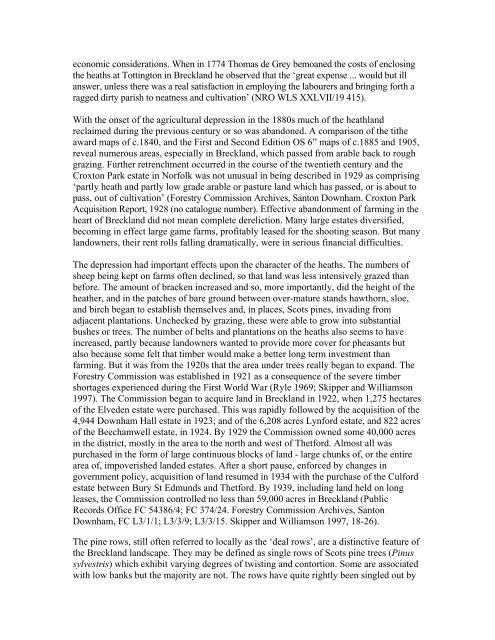The Breckland Pine Rows - Norfolk's Biodiversity
The Breckland Pine Rows - Norfolk's Biodiversity
The Breckland Pine Rows - Norfolk's Biodiversity
You also want an ePaper? Increase the reach of your titles
YUMPU automatically turns print PDFs into web optimized ePapers that Google loves.
economic considerations. When in 1774 Thomas de Grey bemoaned the costs of enclosing<br />
the heaths at Tottington in <strong>Breckland</strong> he observed that the ‘great expense ... would but ill<br />
answer, unless there was a real satisfaction in employing the labourers and bringing forth a<br />
ragged dirty parish to neatness and cultivation’ (NRO WLS XXLVII/19 415).<br />
With the onset of the agricultural depression in the 1880s much of the heathland<br />
reclaimed during the previous century or so was abandoned. A comparison of the tithe<br />
award maps of c.1840, and the First and Second Edition OS 6” maps of c.1885 and 1905,<br />
reveal numerous areas, especially in <strong>Breckland</strong>, which passed from arable back to rough<br />
grazing. Further retrenchment occurred in the course of the twentieth century and the<br />
Croxton Park estate in Norfolk was not unusual in being described in 1929 as comprising<br />
‘partly heath and partly low grade arable or pasture land which has passed, or is about to<br />
pass, out of cultivation’ (Forestry Commission Archives, Santon Downham. Croxton Park<br />
Acquisition Report, 1928 (no catalogue number). Effective abandonment of farming in the<br />
heart of <strong>Breckland</strong> did not mean complete dereliction. Many large estates diversified,<br />
becoming in effect large game farms, profitably leased for the shooting season. But many<br />
landowners, their rent rolls falling dramatically, were in serious financial difficulties.<br />
<strong>The</strong> depression had important effects upon the character of the heaths. <strong>The</strong> numbers of<br />
sheep being kept on farms often declined, so that land was less intensively grazed than<br />
before. <strong>The</strong> amount of bracken increased and so, more importantly, did the height of the<br />
heather, and in the patches of bare ground between over-mature stands hawthorn, sloe,<br />
and birch began to establish themselves and, in places, Scots pines, invading from<br />
adjacent plantations. Unchecked by grazing, these were able to grow into substantial<br />
bushes or trees. <strong>The</strong> number of belts and plantations on the heaths also seems to have<br />
increased, partly because landowners wanted to provide more cover for pheasants but<br />
also because some felt that timber would make a better long term investment than<br />
farming. But it was from the 1920s that the area under trees really began to expand. <strong>The</strong><br />
Forestry Commission was established in 1921 as a consequence of the severe timber<br />
shortages experienced during the First World War (Ryle 1969; Skipper and Williamson<br />
1997). <strong>The</strong> Commission began to acquire land in <strong>Breckland</strong> in 1922, when 1,275 hectares<br />
of the Elveden estate were purchased. This was rapidly followed by the acquisition of the<br />
4,944 Downham Hall estate in 1923; and of the 6,208 acres Lynford estate, and 822 acres<br />
of the Beechamwell estate, in 1924. By 1929 the Commission owned some 40,000 acres<br />
in the district, mostly in the area to the north and west of <strong>The</strong>tford. Almost all was<br />
purchased in the form of large continuous blocks of land - large chunks of, or the entire<br />
area of, impoverished landed estates. After a short pause, enforced by changes in<br />
government policy, acquisition of land resumed in 1934 with the purchase of the Culford<br />
estate between Bury St Edmunds and <strong>The</strong>tford. By 1939, including land held on long<br />
leases, the Commission controlled no less than 59,000 acres in <strong>Breckland</strong> (Public<br />
Records Office FC 54386/4; FC 374/24. Forestry Commission Archives, Santon<br />
Downham, FC L3/1/1; L3/3/9; L3/3/15. Skipper and Williamson 1997, 18-26).<br />
<strong>The</strong> pine rows, still often referred to locally as the ‘deal rows’, are a distinctive feature of<br />
the <strong>Breckland</strong> landscape. <strong>The</strong>y may be defined as single rows of Scots pine trees (Pinus<br />
sylvestris) which exhibit varying degrees of twisting and contortion. Some are associated<br />
with low banks but the majority are not. <strong>The</strong> rows have quite rightly been singled out by





